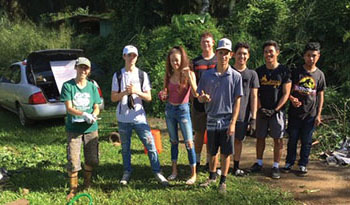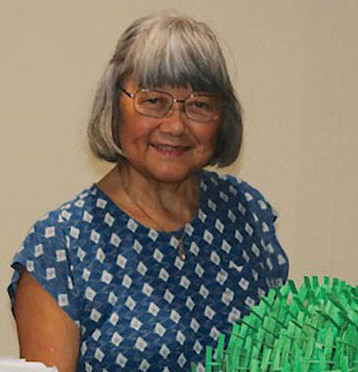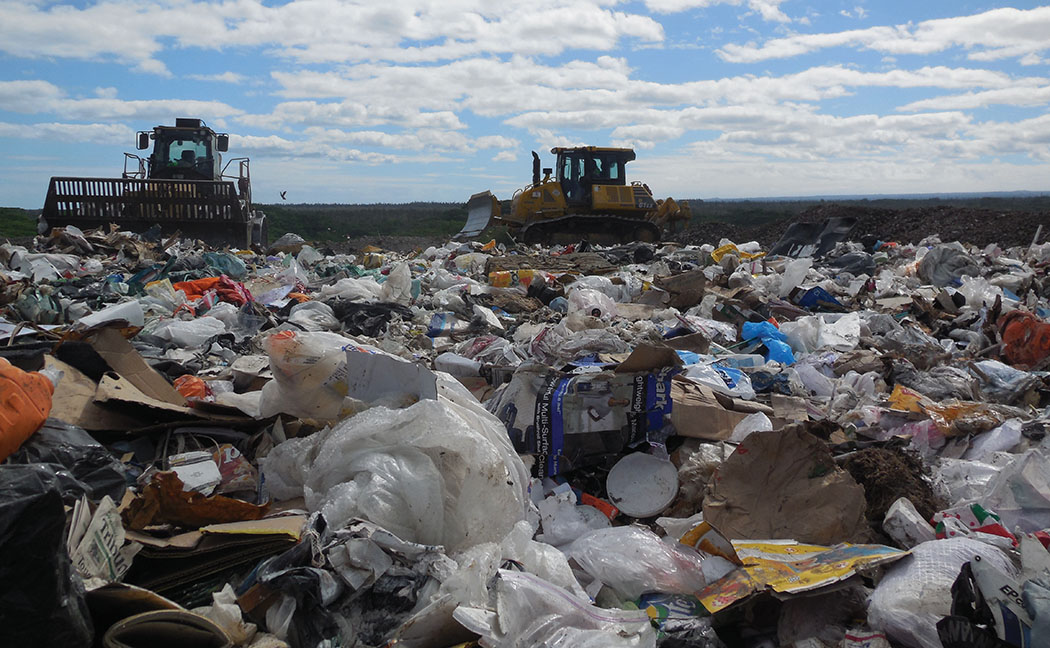
Refuse–Reduce–Reuse–Recycle: Doing Our Part

By Stefan Verbano
The Great Pacific Garbage Patch
Soiled plastic foam takeout containers fly out of a dumpster and whip through the streets on gusts from the tail end of a tropical storm. Some get caught in trees, on fences, in pools, on boats. Others land in the harbor and are washed back to shore riding on waves churned up by the tempest.
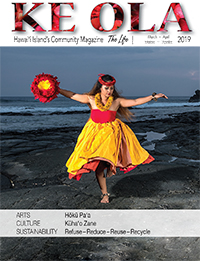
However, one select piece of this non-biodegradable flotsam is blown beyond the harbor by wind and waves out into the open ocean, where it will never make it back to land again. This stained, crumpled hunk of foam has started its long, lonely journey into the circulating ocean currents of the North Pacific Gyre and, at journey’s end, the Great Pacific Garbage Patch.
Also known as the Pacific Trash Vortex, the whirling slurry of floating plastic and other marine debris lies halfway between Hawai‘i Island and California. This mass of debris covers roughly 600,000 square miles (1.6 million square kilometers)—the size of Mongolia, twice the size of Texas, three times that of France, or 150 Hawai‘i Islands.
Although general public conception of the patch tends to be of a massive floating garbage island reminiscent of a Hollywood movie set, that is far from its true form. More iceberg than island, the bulk of the patch lies below the surface, inhabiting that region of the Pacific Ocean’s entire upper water column. The rubbish is so dispersed and of such a low density that detection by satellite imagery is difficult, and casual boaters can sail right through sections without even noticing.
Hawai‘i Island’s Search for Solutions
Hawai‘i Island lies in the middle of the North Pacific Gyre, and its southernmost coast is regularly littered with marine debris bound for the Garbage Patch. The island is in a unique situation in terms of waste management. It is separated from the nearest continental landmass by more than 2,000 miles in every direction; population density is low so residential curbside rubbish collection is virtually nonexistent outside cities; and the island itself lacks the industrial capacity to process most recyclable materials, so for the majority of what it does recycle it must pay to ship to either the West Coast or Asia.
Faced with all of these challenges, out of both principle and necessity, Hawai‘i Island has wholeheartedly embraced the classic environmentalist doctrine of the “Three R’s”: Reduce, Reuse, Recycle.
Since the turn of the 21st century, the conventional triad has been amended in some circles with a fourth “R”: Refuse. Generally, this has come to mean rejecting mostly single-use products considered to be particularly environmentally harmful—like plastic straws or foam take-out containers—and customers’ insistence that similar products be made from reusable, recyclable or compostable materials.
Refuse
Hawai‘i County has not been slow to adopt this new fourth tenet. In 2014, it was one of the first counties in the US to implement a single-use plastic bag ban. According to the Earth Policy Institute, US consumers use approximately 100 billion plastic bags every year—almost one bag per person per day—and globally 10 times as many are used. The only other US statewide plastic bag ban is in California, where legislation passed at the state level first. In Hawai‘i, likely a sign of grassroots organizing power in local politics, the bans were passed county by county until there was a de facto statewide ban.
Bill Kucharski is the director of Hawai‘i County Department of Environmental Management, and he has seen how effective local county-level initiatives can be in changing the behavior behind polluting. “I think it’s the grassroots organizations that weigh strong encouragement for us to modify what we are doing,” Bill says. “They tend to be listened to.”
Starting July 1, 2019, Hawai‘i Island will be the second county in the state to ban plastic foam to-go serving containers, after Maui County’s own foam ban took effect on New Year’s Eve 2018. The State’s Senate Bill 2498 aimed to ban foam containers statewide beginning in January 2019; however, it was defeated in a full senate vote the previous April.
The bill’s passage would have instigated the first statewide foam container ban in the country, going into effect the first day of the new year along with, coincidentally, New York City’s similar citywide foam ban. Hawai‘i lawmakers pledged to keep pushing the bill forward in years to come.
Reduce
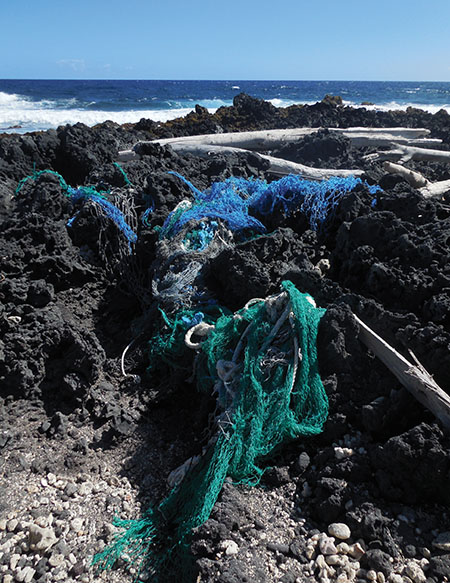
There are two landfills on Hawai‘i Island—the South Hilo Sanitary Landfill adjacent to Hilo Airport, and the West Hawai‘i Sanitary Landfill, Pu‘uanahulu (Waikoloa). The South Hilo facility is expected to reach capacity in spring/summer 2019, when it will be closed, covered, and all of East Hawai‘i Island’s waste will be trucked over the Daniel K. Inouye Highway (Saddle Road) to the West Hawai‘i landfill.
To stem the landfills’ growth, the County has provided green waste diversion services to residents island wide for more than a decade. In what Bill Kucharski calls the Department’s “biggest success story,” 40 to 50 thousand tons of green waste–roughly a quarter of the island’s solid waste stream–are kept out of the two landfills every year and made into mulch and compost.
Marsha Hee, a project manager formerly with the local nonprofit Recycle Hawai‘i, feels part of Hawai‘i Island’s commitment to reducing waste involves its residents being more mindful about where all their imported materials eventually end up when they don’t get recycled.
“Once we have these materials here on our island which we are importing, it’s going to stay here,” Marsha says. “Or at least the majority is going to stay here. The amount that we’re recycling—that we’re shipping back out—is smaller. The rest is going into a landfill.”
Reuse
While working in 2017 at Recycle Hawai‘i, an all-volunteer organization educating island communities about the importance of recycling, Marsha organized an online showcase called “The Art and Craft of Upcycling.” It was an exhibit of functional everyday items made with upcycled materials. Upcycling, also known as creative reuse, is the process of transforming low-quality, low-value unwanted byproducts and waste materials into new, higher-quality and more valuable products. Submissions ranged from bike inner-tube purses to colorful bottle-cap murals, to rugs made out of braided rags.
“In that scenario, people are looking at that bottle cap or piece of plastic,” Marsha says, “and they’re looking at it not just as something that they drank or ate out of, thinking: ‘Oh, now I’m just going to be tossing this away.’ Now they think: ‘But I can use this. It still has value.’”
Mattie Larson is the owner, artist, and designer behind the company UpCycle Hawaii, and her work was featured in Marsha’s showcase. UpCycle Hawaii makes everything from fused plastic zipper pouches to melted marine debris nightlights to reclaimed rubber inner-tube wallets to crocheted aluminum pop-tab purses, all out of garbage.
“I think doing this has really opened my eyes to the amount of waste that we create without knowing it as consumers…the backdoor, behind-the-scenes waste,” Mattie says. “All these businesses are literally unwrapping these mattresses, fenders, whatever, and these plastics that they’re wrapped in get thrown away. So I tap directly into the businesses and do my monthly sweeps into the back warehouses and pull out what I think is of value.”

Recycle
The vast majority of Hawai‘i Islanders—as many as 85 percent—haul their own residential waste and recyclables to one of 23 no-cost, county-run Solid Waste Transfer Stations. Though diligent recycling is a boon to the environmentalism movement everywhere, the actual numbers are a little disheartening. According to the United Nations Environment Programme, “Only nine percent of the nine billion tons of plastic that have ever been produced has been recycled.”
In an isolated place like Hawai‘i Island, with little recycling infrastructure and high transport costs, Bill Kucharski says that free recycling service alone is not an economically sustainable solution to its waste problem.
“Here recycling doesn’t make money, it costs money,” Bill says, adding that recycling is twice as expensive as disposal. “But the county has made the decision that this is a worthwhile endeavor, and it’s willing to carry that expense.”
The demand for recycling services has also grown beyond the County’s ability to meet it. “There’s more people wanting to recycle than we have the capacity of handling,” Bill says. “Sometimes we suffer from our success.”
Marsha Hee envisions a very human solution to this very human problem. “It is a large cycle…a large loop,” she says. “And we are not doing enough on our part to make sure the loop keeps going. In our climate change environment, it’s important we do all that we can. We need to encourage each other, we need to talk to each other about it, and we need to have it be more visible; we need to share it more.” ❖
Refuse
- Support Hawai‘i County’s plastic bag and plastic foam ban.
- As customers, insist on buying products made with reusable, recyclable, or compostable materials/packaging.
- Consider which other single-use plastic products could be easily rejected.
Reduce
- Buy food and other goods in bulk.
- Opt for products with minimal packaging.
- Avoid individually-wrapped products when possible.
- Reduce the amount of green waste in Hawai‘i’s two landfills by always separating compostable materials from trash.
Reuse
- Support companies like UpCycle Hawaii, which use reused/salvaged materials to make their products.
- Try out UpCycling methods on your own: think about what everyday waste items could be remade into artistic or useful items.
- Support thrift and other secondhand stores to keep useable clothes out of landfills.
Recycle
- Educate yourself: County solid waste transfer stations’ guidelines have recently changed. Stay current by following Recycle Hawai‘iʻs website and social media.
- Clean and remove lids from recyclable plastic containers before they go in the bin.
- Participate in the HI-5 program: redeem appropriate bottles and cans for money.
For more information:
hawaiizerowaste.org
wmsolutions.com
recyclehawaii.org
upcyclehi.com
hawaiicounty.gov/dem-solidwaste-division
